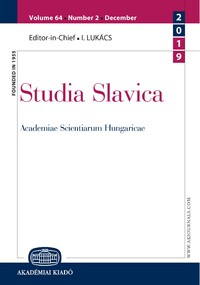Неологизмы эпохи пандемии: маркеры квалификации
Neologisms in the Era of Pandemics: Markers of Qualification
Author(s): Zifa Kakbaevna Temirgazina, Uldanai Bakhtikireeva, Nadezhda Konstantinovna KhanSubject(s): Semantics, Eastern Slavic Languages
Published by: Akadémiai Kiadó
Keywords: “pandemic” discourse; “newspeak”; Covid; scenario; lexical neologisms; semantic neologisms; markers of the novelty of words; visual markers
Summary/Abstract: In the present paper, the intensive beginning stage of the formation of a “newspeak” is observed in the era of pandemics, when native speakers form new words for denoting realia that are new both for them and their experience acquired in extraordinary conditions. The “pandemic” discourse formed by these speakers primarily includes changes in the lexicosemantic system of the Russian language. The aim of this paper is to describe new words (both semantic and lexical neologisms) and define the markers of the novelty of words in the minds of native speakers, which is of certain interest in the active stage of the formation of a “newspeak” in the era of pandemics. The development of pandemics is denoted by the notion of scenario, which in combination with relative adjectives like Italian, Swiss, Chinese, etc. present the specificity of pandemics in various countries. The borrowing Covid, quickly adopted by Russian speakers, becomes a derivative base for many lexical neologisms formed by the addition of word stems and affixation (Covid centre, Covid taxi, anti-Covid). Lexical neologisms form the majority of new words. In the paper, some individual author’s neologisms are also studied, which are based on a pun and serve an expressive function in the language (covidimo-nevidimo). During the analysis of special literature and the survey of native speakers, it was revealed that the markers of novelty have both a logical (“an unusual meaning”) and a visual perceptive character (“an odd-sounding”, “Latin script in spelling”, or “words in inverted commas”). As the survey shows, in the minds of native speakers who do not have any special knowledge, visual markers play a leading role in defining words as new ones. The intuitively perceived marker “an unusual meaning” is supported by visual markers: the spelling and the sounding. In the active period of the functioning of a neologism, its important feature of identification for ordinary speakers of Russian is the metagraphemics (the Latin script and the inverted commas) and the sounding form of a neologism. After some time, a part of external visual markers of the novelty of words is lost, for instance, inverted commas are not used, the Latin script is substituted by the Cyrillic script, and the sounding form of the word becomes usual. This means that the word loses its novelty for Russian native speakers and becomes a common word.
Journal: Studia Slavica Academiae Scientiarum Hungaricae
- Issue Year: 65/2020
- Issue No: 2
- Page Range: 377-392
- Page Count: 16
- Language: Russian
- Content File-PDF

